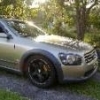M35 Stagea intake suction pipe
Announcements
-
Similar Content
-
Latest Posts
-
Yes. Do thought experiment. Make the left ramp, the 45° ramp, one degree steeper. It will then be 44° from the vertical. What happens to the forces? Too hard to tell? Well, add one more degree, and then keep doing that until it looks exactly like the near vertical wall of the 1-way opening. I would suggest that every degree less than 45° (from vertical) reduces the reaction force, if continually removing them from 45 gets you back to the 1-way profile.
-
It's about how easily it can move it too. It needs more force to go left being at a steeper angle. So since it needs more force, it's going to mean it takes a lot more effort (slip) to get it to push out. As to the right is easier to spread, it's going to be easier for it to lock up.
-
I would think the left side of this is 45 degree and the right side of this is 55 degree. There'd be more pressure with this going left than going right....?




.thumb.jpg.1b7f9b555236b5ea56c3fed20c733de8.jpg)



Recommended Posts
Create an account or sign in to comment
You need to be a member in order to leave a comment
Create an account
Sign up for a new account in our community. It's easy!
Register a new accountSign in
Already have an account? Sign in here.
Sign In Now